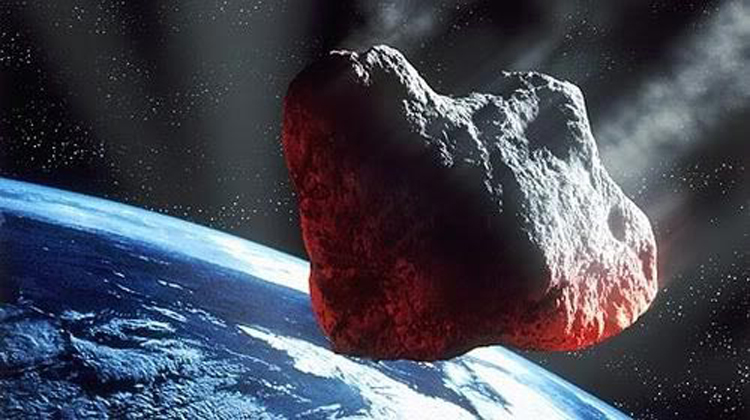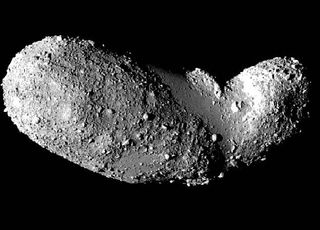
Humanity has the skills and know-how to deflect a killer asteroid of virtually any size, as long as the incoming space rock is spotted with enough lead time, experts say.
Our species could even nudge off course a 6-mile-wide (10 kilometers) behemoth like the one that dispatched the dinosaurs 65 million years ago. We'd likely have to slam multiple spacecraft into a gigantic asteroid over a period of several decades to do the job, but the high stakes would motivate such a strong and sustained response, researchers say.
"If you can hit it with a kinetic impactor, you can hit it with 10 or 100 of them," former NASA astronaut Ed Lu, chairman and CEO of the nonprofit B612 Foundation, which is devoted to protecting Earth against asteroid strikes, said during a news conference last month. [Photos: Potentially Dangerous Asteroids Up Close]
"And I would submit to you that if we were finding an asteroid that's going to wipe out all life on Earth, or the majority of life on Earth, that funding is not an issue for launching 100 of them," Lu added.
Undiscovered asteroids
Lu and four other spaceflyers spoke Oct. 25 at the American Museum of Natural History in New York City. A primary purpose of the event was to draw attention to the danger asteroids pose to human civilization and life on Earth, and to discuss ways to mitigate the threat.
Earth has been pummeled by space rocks repeatedly over the eons and will continue to get hit, a reality that was reinforced in February when a 55-foot-wide (17 meters) space rock exploded in the atmosphere over the Russian city of Chelyabinsk, injuring more than 1,000 people.
Get the Space.com Newsletter
Breaking space news, the latest updates on rocket launches, skywatching events and more!
The Russian meteor came out of nowhere, evading detection by the various instruments that are scanning the heavens for potentially hazardous objects. And there are many more such space rocks out there, gliding through deep space unknown and unnamed. [Meteor Explodes Over Russia (Video)]
To date, scientists have discovered about 10,000 near-Earth objects, or NEOs — just 1 percent of the 1 million or so asteroids thought to come uncomfortably close to our planet at some point in their orbits. So the top priority of any asteroid-defense effort should be a stepped-up detection campaign, Lu said.
"Our challenge is to find these asteroids first, before they find us," he said. "You cannot deflect an asteroid you haven't yet found."
To make progress on the detection front, the B612 Foundation is developing a privately funded infrared space telescope called Sentinel, which will search for asteroids from a Venus-like orbit. The group aims to launch Sentinel in 2018 and says it will likely find 500,000 NEOs in less than six years of operation.

Deflecting dangerous space rocks
Scientists hope Sentinel and other asteroid-hunting instruments will spot dangerous NEOs several decades before they could potentially slam into Earth.
That's enough lead time to mount a successful deflection effort, which would likely involve launching two separate space missions, former Apollo astronaut and B612 co-founder and chairman emeritus Rusty Schweickart told SPACE.com earlier this year.
The first mission, he said, would send a robotic probe on a collision course with the asteroid, knocking it off course via kinetic impact. The second would follow up, launching a "gravity tractor" spacecraft to fly along with the space rock, nudging it further via a tiny but consistent gravitational tug.
Such a strategy would probably work on asteroids up to 1,300 feet (400 m) wide, Schweickart said at the Oct. 25 press conference. Anything bigger than that likely demands a different response, he added, such as a series of kinetic impacts or blasting the asteroid with a nuclear bomb.
Infrequent events
Colossal asteroid impacts that cause mass extinctions are extremely rare events. For example, strikes like the one that killed off the dinosaurs (and roughly 80 percent of all Earth's species) 65 million years ago happen roughly once every 100 million years, Schweickart said.
But smaller (and much more frequent) strikes can still be devastating. In 1908, an object thought to be just 130 feet (40 m) wide, or perhaps even smaller, exploded above the Podkamennaya Tunguska River in Siberia, flattening roughly 770 square miles (2,000 square km) of forest.
Impacts like the "Tunguska Event" — which would have destroyed New York City, Tokyo or any other metropolis if they had been in the asteroid's crosshairs — occur once every 300 years on average, Schweickart said.
So it makes sense to focus on city-killers and other relatively small asteroids rather than the behemoths when thinking about how to deflect space rocks — especially since the true giants are so easy to spot.
"We're not going to be surprised by something that large," Schweickart said of asteroids like the dinosaur-killer. "We will have lots of time to worry about it, or mix our martinis, or whatever we're going to do."
Follow Mike Wall on Twitter @michaeldwall and Google+. Follow us @Spacedotcom, Facebook or Google+. Originally published on SPACE.com.
Join our Space Forums to keep talking space on the latest missions, night sky and more! And if you have a news tip, correction or comment, let us know at: community@space.com.

Michael Wall is a Senior Space Writer with Space.com and joined the team in 2010. He primarily covers exoplanets, spaceflight and military space, but has been known to dabble in the space art beat. His book about the search for alien life, "Out There," was published on Nov. 13, 2018. Before becoming a science writer, Michael worked as a herpetologist and wildlife biologist. He has a Ph.D. in evolutionary biology from the University of Sydney, Australia, a bachelor's degree from the University of Arizona, and a graduate certificate in science writing from the University of California, Santa Cruz. To find out what his latest project is, you can follow Michael on Twitter.











